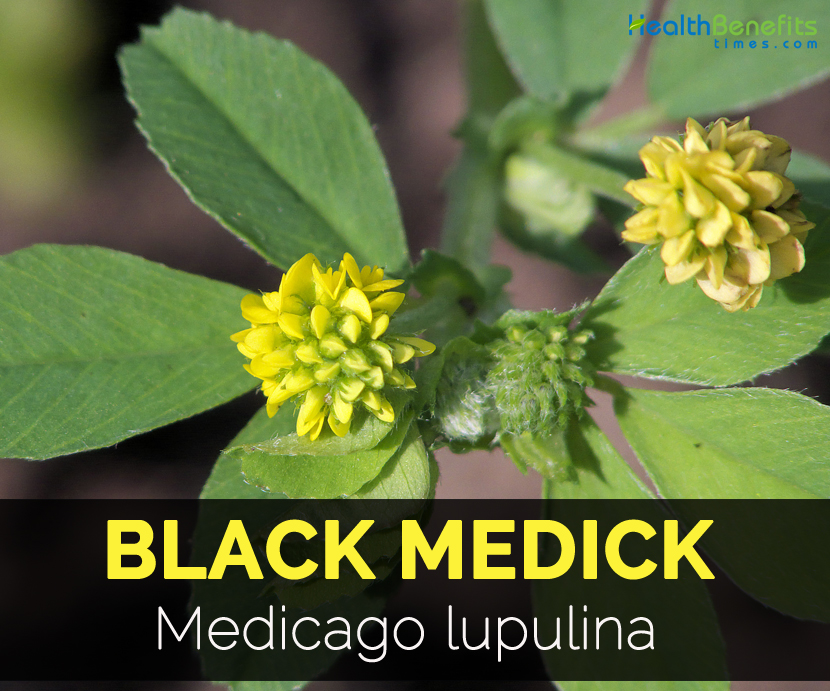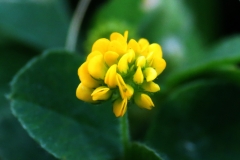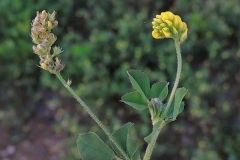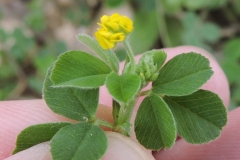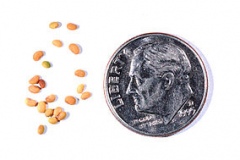It is native to Europe, near east, north Africa and most of Asia including China, India and Korea. It is naturalized in central Asia, South Africa, Japan, New Zealand, Australia, Canada, the United States and South America. It is found throughout United States including Alaska and Hawaii. It thrives well in dry to moist and well drained soils.
Corolla is yellow, zygomorphic and 2–3 mm (0.08–0.12 in.) long and fused at base. Calyx is five lobed. Inflorescence is an axillary, globose-elongated, long stalked and dense raceme.
Leaves
Leaves are stalked, stipulate and alternate. Leaflets are obovate having notched tips and sharp pointed or tip with toothed margins.
Fruit
Fruits are kidney shaped, glabrous, net veined, coiled and 1.5-3 mm (0.06-0.12 in.) long. It is a one seeded, brownish black and indehiscent pod.
Habitat
Medicago lupulina is found in roadsides, lawns, waste ground, harbours, railway yards and shores.
Culinary uses
- Cook the seeds and leaves and use it as potherb.
- Ground the seeds into powder.
- Sprouted seeds are consumed.
References:
https://www.itis.gov/servlet/SingleRpt/SingleRpt?search_topic=TSN&search_value=503721#null
http://www.hear.org/pier/species/medicago_lupulina.htm
https://pfaf.org/User/Plant.aspx?LatinName=Medicago+lupulina
https://en.wikipedia.org/wiki/Medicago_lupulina
https://plants.usda.gov/core/profile?symbol=MELU
https://wimastergardener.org/article/black-medic-medicago-lupulina/
Comments
| Black Medick Quick Facts | |
|---|---|
| Name: | Black Medick |
| Scientific Name: | Medicago lupulina |
| Colors | Black |
| Shapes | 2-3 mm |
| Name | Black Medick |
|---|---|
| Scientific Name | Medicago lupulina |
| Common/English Name | Black medick, hop clover, nonesuch |
| Name in Other Languages | Latvian: Apinveida Lucerna; Lithuanian: Apynine Liucerne; Armenian: Arvuit Gailukanman; Afrikaans: hopmedicago; Chinese: tian lan mu xu; Danish: humle-sneglebælg; Dutch: hopperupsklaver; English: black medick, hop clover, black trefoil, trefoil, yellow trefoil; Finnish: nurmimailanen; French: lupuline, minette, luzerne lupuline, minette dorée; German: gelbklee, hopfenklee; Hungarian: komlós lucerna; Italian: lupolina; Japanese: kometsubu umagoyashi; Korean: jan gae ja ri; Nepalese: pahenlo pyauli; Norwegian: snegleskolm; Polish: lucerna nerkowata; Portuguese: alfalfa-lupulina, luzerna-preta, luzerna-lupulina, trevo-amarelo; Russian: liutserna khmelevidnaia, liutserna khmelevaia; Slovenian: hmeljna meteljka. Spanish:- Mexico: alfalfa lupulina, carretilla Catalan: carretón, fenarola-menuda, herba de la desfeta, lupulina, melgó menut, meligón, mielga azafranada, mielga, mielga negra, trèvol; Swedish: humlelusern, humleluzern; Chinese: tian lan mu xu |
| Plant Growth Habit | Annual or short-lived perennial herbs |
| Plant Size | 1 to 2 feet length |
| Stem | Procumbent or ascending |
| Flowering Season | Late spring to early fall |
| Flower | Yellow, 2-3 mm |
| Pod shape & size | Black, 1.5 to 3 mm in diameter |
| Seed | Single, oval to kidney shaped, yellow to olive green, 2 mm long x I mm wide |


